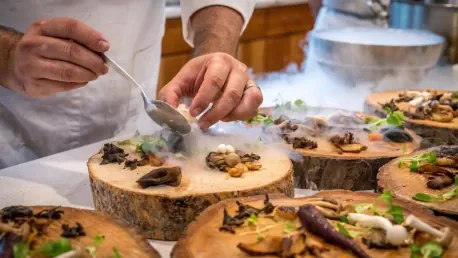Digital marketing for restaurants is essential to thrive in a highly competitive landscape. With customers increasingly turning to online platforms for recommendations, reviews, and reservations, a strong online presence can make or break your business. Leveraging digital platforms, you can stand out from the crowd, attract more customers, and enhance your brand’s visibility. Here, we outline the key digital marketing strategies that can help restaurants thrive in 2024.
1. Create an Outstanding Website
You can leverage many digital marketing strategies to leave your mark online and stand out from the crowd, but having a stellar website serves as the foundation for all online activities. With about 82% of restaurants in the United States maintaining a social presence, creating an intuitive, aesthetically pleasing website becomes indispensable. Your website acts as a digital dining space and can significantly influence a customer’s first impression of your restaurant.
An outdated or slow website will likely deter potential customers. A beautifully designed website with easy navigation can seamlessly guide users to essential sections like the menu, specials, catering services, and contact information. To achieve this, ensure that your website is mobile-responsive, loads quickly, and is updated regularly. Highlighting positive customer reviews, mouth-watering images of your dishes, and easy reservation options can be highly persuasive in converting website visitors into actual diners.
For instance, Bella Roma Grill in Rome, GA, has successfully outpaced its competitors by prioritizing digital media. Their website offers a user-friendly experience, guiding guests effortlessly from menus to catering options. As a result, they’ve seen an increase in reviews, word-of-mouth referrals, and catering submissions. This example illustrates that investment in a great website can yield remarkable results and enhance customer engagement.
2. Focus on Search Engine Optimization (SEO)
Another important strategy for online marketing for restaurants is search engine optimization (SEO). It can help your site rank higher on search results, playing a crucial role in online visibility. Why is this crucial? Given that only 0.63% of all searchers click on the second page of Google, grabbing a spot on the first page is a surefire way to ensure people can discover you.
Don Grantham, Director of Evolve Media, urges restaurant owners to consider SEO an important part of their digital marketing strategy. Here are some best practices to do so: Identify relevant keywords: Use tools like Google Keyword Planner to find popular and location-specific phrases that customers are searching for. Long-tail keywords (at least 3 words) are more specific and attract highly relevant traffic. Optimize on-page elements: Make sure each web page’s title tags, meta description, headings, and body include relevant keywords. Use natural language and avoid keyword stuffing. Ensure mobile responsiveness: A clean, intuitive website design is easy to navigate on all devices, including tablets and smartphones. Make it easy for customers to contact your restaurant by enabling click-to-call buttons and integrating maps for directions.
By focusing on these aspects, restaurants can significantly boost their online visibility, making it much easier for potential customers to find them. In the highly competitive restaurant industry, effective SEO can be the difference between a bustling dining room and empty tables.
3. Commit to Content Development
Content marketing should be an integral part of your SEO strategy, as keyword-optimized content can help you boost website visibility. Additionally, it is an excellent way to establish your restaurant as an authority within your niche and use your brand’s voice to interact with your community.
Leverage the following content formats to connect with your target customers, showcase your unique offerings, and enhance your brand visibility:
- Blogs: Research topics relevant to your restaurant and your target audience. This can include recipes, interesting stories, reactions to industry-related news and events, your achievements, and other engaging content that aligns perfectly with your brand’s vision and mission.
- Videos: Use high-quality visuals to showcase your signature dishes, cooking techniques, and the inspiration behind your menu. You can also record video testimonials from satisfied diners as social proof of the quality of your restaurant.
- Interactive content: Connect with your audience directly through polls, contests, giveaways, and virtual cooking classes.
High-quality content not only improves your SEO but also provides value to your audience, encouraging them to visit your restaurant and share their experiences. Engaging content can create a deeper connection with your audience, making your restaurant more memorable and enticing.
4. Utilize Social Networks
Social media can be an excellent tool when it comes to internet marketing for restaurants. For starters, it enables establishments to market and advertise their services and food on a variety of channels, build communities, and leverage paid advertising. On the other hand, with nearly 75% of users using Facebook to choose eateries based on reviews, pictures, and comments, social media can be a great way to expand your reach organically.
Social media isn’t just a variety of platforms used to boost brand awareness. Instagram and Facebook have also started implementing features that can help restaurants, like the reserve button. It can transform your social pages into potential booking tools, enabling prospects to make reservations easily and quickly.
One effective strategy is to regularly post high-quality images and videos that showcase your dishes, events, and customer experiences. Engaging with followers through comments, polls, and questions can also foster a sense of community and loyalty. Leveraging paid advertisements to target local audiences can further enhance visibility and draw in new customers.
5. Partner with Influencers
Leverage influencer marketing to further enhance brand visibility online and attract new customers. By partnering with food bloggers and local personalities, you can create buzz around the dining experience. Influencers have cultivated trust in their established audiences and provide authentic recommendations they will likely follow. Working with local influencers can attract nearby customers and generate more foot traffic. Make sure the influencer’s audience aligns with your target market so you can maximize return on investment (ROI).
Influencers can showcase your restaurant to a broader audience, particularly those who may not have discovered it otherwise. This exposure can lead to an increase in reservations and overall interest in your restaurant. Hosting events and inviting influencers to attend can also create a sense of exclusivity and excitement, encouraging their followers to visit your establishment.
6. Maintain Customer Relationships with Email Campaigns
Data suggests that email marketing yields an impressive average return of $53 for every dollar invested. Combining this with consumers’ preference for personalized promotional messaging, sending tailored messages to your email list based on past preferences and history can go a long way toward retaining your current guests. If you are using a customer relationship management platform such as Eat App, you can create customer segments and target them with tailored email campaigns.
Sending regular newsletters featuring upcoming events, special promotions, and updates can keep your restaurant top of mind for customers. Personalizing these emails with their name and preferences can make them feel valued and appreciated. Offering exclusive discounts or early access to new menu items through email campaigns can also incentivize repeat visits.
7. Leverage Customer Reviews
Reviews can make or break your establishment. According to experts, for every star you receive in an online directory, you can expect a 5% to 9% revenue increase. However, getting bad reviews can have catastrophic outcomes for your eatery. According to Fernandez, reviews can be excellent growth tools: “Online reviews on main directory listings and opportunities to get an organic promotion are cost-effective ways to garner growth. These are both synonymous with word-of-mouth marketing.”
That said, he also advises approaching negative reviews cleverly: “Embrace every review, good or bad. Your response can often matter more than a review. Remember to not feed the fire, no matter how irritating someone is. Don’t make it personal or use any ‘you’ statements. I recommend using a calm, collected tone and not letting feelings get in the way.” Grantham also agrees that responding to reviews often means more than the review itself. Addressing negative reviews on Yelp, social media, or any other review platform reassures the customer base that you recognize and acknowledge the issue if the review is valid. It’s also a great opportunity to state how you are making it better or what you’ll be doing to rectify the situation and work to establish a positive experience in your customer’s mind.
8. Implement Online Advertising
Restaurants are location-based businesses, making it essential to target your local market both with SEO and focused, paid online advertising to maximize your reach across the digital realm. One way to achieve this is by leveraging social media advertising to target people in your specific area, along with relevant users from your target demographic. Using Google Ads can help you boost your visibility and traffic while your SEO campaigns gain momentum.
Running targeted ads on platforms like Facebook, Instagram, and Google can help you reach potential customers who are already interested in dining out. Craft effective ad copy and use compelling images to catch users’ attention, and include clear calls to action to encourage bookings or visits. Regularly monitoring and optimizing your ad campaigns can ensure you’re getting the best possible return on your investment.
9. Ensure Consistency in Online Listings and Contact Info
Restaurants should optimize their Google Business Profile and NAP (Name, Address, Phone) information. Share consistent business details across online directories and create location-specific content on their sites. This can considerably boost online discoverability, which can eventually help with the foot traffic to an establishment. These business profiles help reach customers and provide all the relevant information they may seek in one place. As such, always keep the profile updated and respond to user reviews as quickly as possible.
Google has also added a booking button for its business profiles, so optimizing your profile on this directory can help you get direct reservations from people who discover your restaurant via search results. Additionally, ensure that the information on Google Business Profile matches the information on other directories, such as Yelp or TripAdvisor.
Keeping your contact details, opening hours, and menu information up to date across all platforms can prevent potential customers from feeling frustrated and turning to competitors. By providing accurate information, you create a seamless experience for users searching for their next dining destination.
10. Incorporate Online Ordering Options
Offering a seamless online ordering system can significantly boost sales, attract new customers, and improve the overall dining experience. Offer clear menu categories with enticing images and descriptions per item and provide an intuitive checkout process on your website. Promote online ordering through social media and email marketing. Incentives like free delivery on the first order, exclusive online-only discounts, and loyalty programs can help encourage customers to order directly through your website.
Delivery service partnerships with third-party platforms like Uber Eats, DoorDash, and Grubhub can also further expand your reach. Consider the commission fees for each platform, as they can be notoriously high. Integrating an online ordering system directly into your website can be beneficial, as it allows you to maintain control over the customer experience and avoid third-party fees.
11. Track and Analyze Campaign Outcomes
Implementing these strategies is only the beginning. You also need to know whether your efforts are paying off. This is where tracking your performance through digital marketing analytics can help you. Analytics cover a range of tools and strategies that help you assess the success and value of your marketing efforts and leverage current data to fine-tune future campaigns.
Monitoring key performance indicators (KPIs) like website traffic, engagement rates, conversion rates, and return on investment (ROI) can give you insights into which strategies are working and which need adjustments. Using tools like Google Analytics and social media insights can provide a detailed analysis of customer behavior and preferences, helping you make informed decisions for future campaigns.
Of course, for the best results, it’s instrumental that the digital marketing agency you choose specializes in strategies that work for restaurants. By continually assessing your performance and adapting your approach, you can ensure that your digital marketing efforts are consistently driving growth and meeting your business objectives.
Conclusion
In today’s fiercely competitive market, digital marketing is crucial for restaurants to succeed. With more and more customers relying on online platforms for recommendations, reviews, and reservations, your business’s digital presence can either make you or break you. A robust online profile not only helps you stand out from competitors but also attracts more patrons and boosts your brand’s visibility.
To help your restaurant thrive in 2024, focusing on key digital marketing strategies is essential. For starters, an engaging website optimized for both desktop and mobile devices can significantly enhance user experience. Alongside a well-designed website, leveraging social media platforms like Instagram, Facebook, and Twitter allows you to connect directly with your audience. Sharing mouth-watering images, behind-the-scenes content, and customer testimonials can engage followers and turn them into loyal customers.
Search engine optimization (SEO) is another critical component, ensuring your restaurant appears in search results when potential customers look for dining options. Also, consider email marketing campaigns to inform your clientele about new menu items, special offers, and upcoming events.
Online reviews on platforms like Yelp and Google Reviews can heavily influence a person’s decision to dine at your restaurant. Encourage satisfied customers to leave positive reviews and promptly address any negative feedback to demonstrate your commitment to service excellence.
Finally, utilizing online reservation systems can streamline bookings and improve customer satisfaction. By incorporating these digital marketing strategies, you can significantly enhance your restaurant’s online visibility and ultimately drive more foot traffic through your doors.









